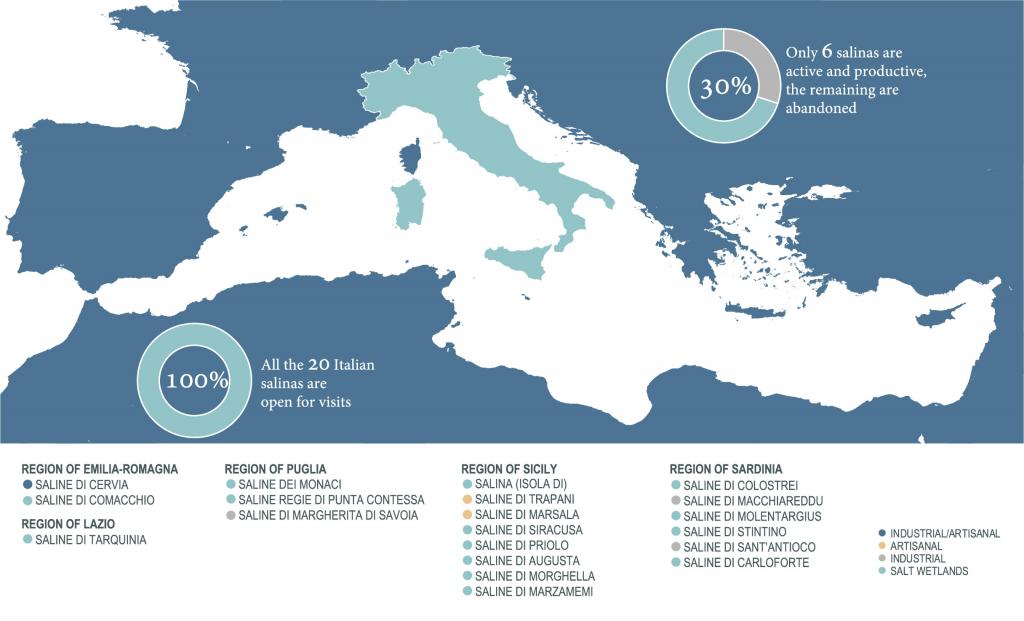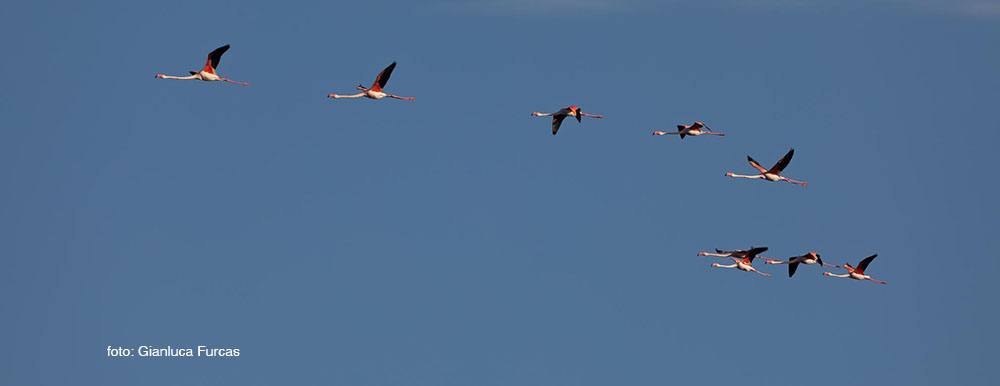Funded by the ENI CBC Med Programme, the project MedArtSal combines the forces of four Mediterranean countries (Italy, Spain, Tunisia and Lebanon) to define a sustainable management model for the revival of artisanal salinas across the Mediterranean.
Salt and saltworks have always been part of the Mediterranean soul. Throughout the ages, the worth of the savory mineral, the “divine substance”, as Homer called it, was so high that it gave rise to myths and religious cults among a variety of cultures. Before the discovery of refrigeration methods, salt was so precious for the seasoning and preservation of food that it became a currency. Indeed, in different periods of history where protracted conflicts over the control of borders and long territorial explorations were routine, salt could mean survival and therefore became a symbol of power. Under these premises, it can be understood why, in the XV century, in a yet split Italy, when the Duchy of Ferrara begun to take control over the saltworks at Comacchio - reserved to the Republic of Venice by a commercial pact - a contest over the commerce of salt easily burst. Due to its crucial value, the “white gold” travelled along endless shipping routes, connecting shores in the web of relations that we easily recognize as Mediterranean heritage.

Saltpans have always represented a perfect example of harmonious cohabitation between human activities and environmental preservation. Nowadays, however, as many other traditional production activities in the world, Mediterranean salinas suffer from the industrialization of the extraction process while their inhabitant species risk to be endangered by coastal urbanization. Actually, salinas host hundreds of ornithological species. Beautiful, rare and fragile birds as flamingos, avocets and numerous types of waders, nest and winter in the transition areas of the wetlands.
At present, only twenty of countless ancient saltpans, remain in the Italian territory. Four sites (S. Antioco, Trapani, Santa Margherita di Savoia and Cervia) have shifted to industrial production. All the others, have been abandoned, becoming either Sites of Community Interest (SCI) or Special Protected Areas (SPA). Several of them are also Ramsar sites. Only Cervia, Trapani and Marsala have been able to preserve the artisanal tradition, though wiped out by salt depreciation, mass production and the lack of generational change.
Italian saltworks are not only inestimable environmental oases, they also offer amazing scenarios with the potential to attract cultural and tourist activities. Cervia, in Emilia Romagna, northern Italy, is a brilliant example of the possibilities lying in innovation. When salt production started to be perceived as non-profitable, the local community worked hard to save an activity that, along with the landscape, had become an integral part of its identity. The unique treatment of its “sweet” salt takes place amid a park of rare beauty, dwelled by an incredible variety of animal species. Visitors can walk around the natural reserve, discover its history in the Salt Museum and buy salt-based food products and cosmetics.
A forward-looking project has since the mid-1990s allowed Trapani’s saltpans to survive and thrive. In the “Trapani and Paceco” natural reserve, managed by the WWF, artisanal salt production is surrounded by salicornia stretches and accompanied by the flight of the marsh harriers and the white heron, by the avocet’s elegant bearing that, together with the old windmills, have become symbolic of the reserve’s natural landscape.
Heron and flamingos, along with other 50 species, inhabit the Conti Vecchi salinas of Cagliari, Sardinia. Since 2017, the old production complex, cradle of a “salt community” that lived sustainably as one with the surrounding wetlands, has become a fascinating site of industrial archeology. Extraction has been saved, and small hills of shining salt run along the pond’s shores, while a wheeled train brings visitors through the production sites: the old office, the laboratory and the carpenter’s shop become stops along a charming travel through time.
Not everything is lost. However, to respond resourcefully to the challenges that modernity places us before, we need new and shared energies and ideas. Ancient harmony can and must be reestablished with the collaboration of producers and consumers. The EU-Med cooperation project MedArtSal, will result in setting up a new business paradigm that will benefit artisanal saltpans through the strengthening of partnerships with various subjects involved in the sectors of sustainable production and tourism, fostering collaborations at business, social, environmental and, not less importantly, at governance level. An integrated, virtuous circuit can attract consumers’ interest, fed by the awareness that buying artisanal salt and new sustainable products derived by its treatment means preserving an ecosystem, a place of beauty and knowledge.
References:
Saline d’Italia, di Armando Gariboldi - Parchi e Riserve Naturali n.1/2005
Linee guida per la gestione ambientale delle saline del Mediterraneo e del Mar Nero - Modello gestionale. http://www.mc-salt.eu/files/00104/management_modelitalia_ok.pdf
Latest news

DEEP DIVE: The Alarming State of the Ocean – Inspiring Action and Searching for Solutions (Webinar)
In celebration of World Ocean Day, MEDSEA invites you to the online event "Deep Dive: The Alarming State of the Ocean", a detailed analysis of the challenges that oceans are…

Fire Monitoring Test successfully conducted in Santu Lussurgiu thanks to IoT Technologies
At the end of April, a major breakthrough in fire prevention technology was achieved in the forests of San Leonardo. Thanks to pre-fire detection sensors, an IoT (Internet of Things) technology developed and…

REST COAST, at the annual meeting in Groningen, demonstrates the effectiveness of natural restoration of aquatic systems
The standstill of the Nature Restoration Law, the European law on nature restoration, stalled in its final approval phase in the Council due to the hesitations of some Member States, has…

TransformAr makes a stop in Finland for the sixth Consortium Meeting
In mid-April, the sixth Consortium meeting of the H2020 TransformAr Project was held in Lappeenranta, recognized as the Climate Capital of Finland. This city truly exemplifies sustainability, with 100% of waste recycled and all…

Launch of the PLASTRON Project in Genoa: A Cross-Border Initiative for the marin Plastic & Paper Recycling
The PLASTRON project is about to start. With the goal of improving the sustainability of local communities by providing knowledge and tools for collecting and transforming plastic from the coast…

Wetland4Change to Address Climate Change with Wetlands, Kickoff in Sofia
Last week, hosted by the University of Forestry in Sofia, the kickoff of "Wetland4Change" took place, marking the start of an ambitious Interreg Euro-MED project within the Natural Heritage Mission aimed at…

The Capo Carbonara Marine Protected Area towards a New Zoning with Blue4All
A new co-management model to reorganise marine protected areas, benefiting from all the tools and knowledge provided by the Blue4All project will be soon implemented in Sardinia. Later last month, preliminary meetings…

TransformAr, Adaptation Pathways to Climate Change for Fishing Validated, All Set for Sensor Installation
TransformAr enters its most operational phase at the pilot site in Oristano where, in March, the MEDSEA team met with the Municipality of Terralba and the fishermen of the San Giovanni Lagoon from the Marceddì Consortium to…

Revitalizing the Mediterranean: ARTEMIS Project Unites Environment and Innovation
March marked the launch of "Artemis", a project of the Interreg Euro-MED Programme that seeks to combine the ecological benefits of seagrass with innovative financial strategies, such as Payment for Ecosystem…

Petit Noirs: From Senegal to Arborea to Combat Illegal Immigration with Mussel Farming
Sustainable mussel farming in Arborea becomes an international example with a project linking Dakar, Senegal, with Sardinia, aiming to combat illegal immigration and generate economic opportunities.

The Charm of Wetlands in Sardinia: Over a Thousand Visitors in the World Wetlands Day Event Calendar in Sardinia"
With over 30 events, from January 27 to March 10, 2024, the MEDSEA World Wetlands Day in Sardinia comes to a close. The initiative, which falls in the month when wetlands are…

First Meeting of the DesirMED Project in Venice: A Step Forward in Climate Adaptation in the Mediterranean
Last month, the historic city of Venice hosted the first meeting of DesirMED, a project funded by the HORIZON Europe program aimed at addressing one of the most pressing challenges of…

Sails Towards the Future: The UniCa Sailing Team and the Challenge of Eco-Sustainable Boats in Sardinia
In Sardinia, circular and low-impact solutions for water sports and sailing are being studied. The University of Cagliari, together with the UniCa Sailing Team, is working on the construction of an…

The first General Assembly kicked off in Lecce: for a more resilient MPAs network
The first General Assembly of the "Blue 4 All" project took place in Lecce from January 23 to 26, 2024. The event, hosted by the CMCC Climate - Euro-Mediterranean Center on Climate…

It's Time to Celebrate Wetlands: join World Wetlands Day Sardegna 2024
In Sardinia, February is the month of wetlands! We celebrate World Wetlands Day on the occasion of February 2nd, which marks the 53rd anniversary of the establishment of the RAMSAR Convention for…

TransformAR Reaches Halfway: The Progress in the San Giovanni Lagoon
TransformAR, at the pilot site of Marceddì-San Giovanni (Terralba) in Sardinia, one of the six demonstration sites of the project, is gaining momentum. The project, which develops transformative adaptation solutions to climate change…
- 1
- 2
- 3
- 4


